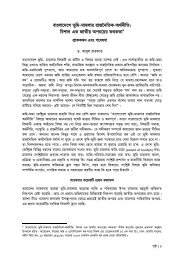08. Costing Essential Services Package An Issue Paper
08. Costing Essential Services Package An Issue Paper
08. Costing Essential Services Package An Issue Paper
You also want an ePaper? Increase the reach of your titles
YUMPU automatically turns print PDFs into web optimized ePapers that Google loves.
<strong>Costing</strong> <strong>Essential</strong> <strong>Services</strong> <strong>Package</strong>: <strong>An</strong> <strong>Issue</strong> <strong>Paper</strong> 8<br />
utilities, methods of estimating costs through apportionment are needed below static facility<br />
level. This is due to the fact that using perfect bottom-up method would be expensive and<br />
generate insufficient additional information to be of appropriate utility. As a result, as rightly<br />
stated by Tim Ensor, most costing methods will employ a combination of bottom-up accounting<br />
and top-down allocations (Ensor 1999).<br />
Finally, the expenditure allocation and full cost accounting (Figure 4) are two other methods<br />
distinctly different from one another. These are essentially the differences between cost<br />
concept in accounting and that in economics (opportunity cost) (Figure 5). Expenditure<br />
allocations usually uses actual past, or current expenditure, or future budgets as the basis for<br />
allocating (assigning) `costs’ of services. The difference between the budget and actual is<br />
basically the difference between what is and what has to be. The degree of such difference<br />
depends on whether budgets are based on normative or on practical estimation of the feasible<br />
resource envelope (Ensor 1999). The later situation will be closer to the true cost. Budgetbased<br />
normative costing in health, although practised in various countries, is outdated since the<br />
norms are based on notions of capacity, which does not consider the effective treatment<br />
technologies and may lie far from the actual cost of treatment and conditions.<br />
There are many reasons as to why costing based on top-down and bottom-up methodologies<br />
generate widely diverge results. Ensor has identified two prominent reasons for such<br />
divergence (Ensor 1999): First, expenditures as recorded by the health service management<br />
information system, may not fully record expenses incurred but only payments made. This<br />
distinction between income-expenditure and receipts-payment accounting can mean that if a<br />
payment, perhaps monthly salaries or a bill for equipment, is delayed until the next financial<br />
year then it is not recorded. As a consequence they might appear cheaper than they actually<br />
are. Full expenditure accounting must include these unpaid debts. In addition, where a patient<br />
makes up the cost of care from her own pocket, through a contribution to the cost of drugs of<br />
food, this should also be included in the cost of care. Adequate allowance must also be made<br />
for amortisation of equipment and building costs. A second reason for the divergence is that<br />
health facilities operating under resource constraints will deliver a different pattern of service<br />
activity than those working with more resources or a smaller package of services. Where<br />
resources are spread thinly, survival may mean reducing activity unless patients can make up<br />
the cost of care themselves. Since the patients are able to contribute to the cost may well differ<br />
from those most able to benefit from (essential) services, the pattern of resource use becomes<br />
distorted. As a result, costs based on ideal activity patterns will differ from those that are<br />
actually observed. Thus, Ensor rightly differentiates costs from expenditure; and this may be<br />
right to conclude that what we do by the name of costing ESP essentially falls in the category of<br />
expenditure estimation or partial costing (which may be far from true costing). 3><br />
Thus, the measurement of costs is by no means an easy task. Irrespective of top-down or<br />
bottom-up methodologies, the major difficult conceptual and practical issues are related to the<br />
choice of concept – accounting or economic (opportunity) costs. Choice of concept will<br />
depend on the purpose of costing. If we need to know the (true) full cost of ESP, the choice<br />
obviously would be in favour of economic cost, which is undoubtedly important from the financial<br />
sustainability point of view. However, if we need to know only about the amount of public sector<br />
budgetary allocation for ESP (or HPSP), accounting cost will suffice. Here it would be useful to<br />
3> The discrepancy between the total ESP expenditure and total ESP cost can be indicated through the following: the<br />
Year 1 total ESP expenditure is Tk.14,465 million (69.89% of HPSP; GoB 1998a: 77-78); whereas the household<br />
health care expenditure in 1994-95 was Tk. 37,894 million (with 62% on account of medicines and 10% on travel:<br />
See Rabbani et.al., 1999: 133). It is obvious that some parts (extent is not known to us) of the household health<br />
care expenditure is related to various areas of ESP.






